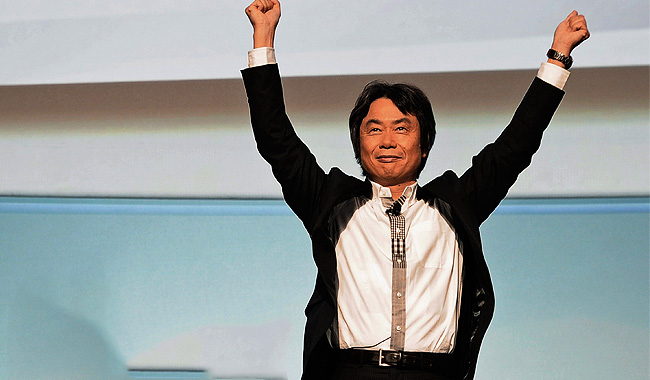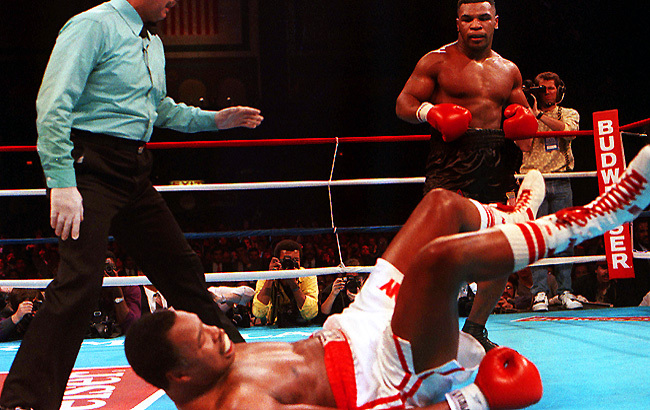There are few 8-bit games more fondly remembered than Nintendo’s Punch-Out!! The game may have been simple and not as influential as, say, Super Mario Bros. or The Legend of Zelda, but it made up for that with a cast of indelible characters and, for a short time, at least, the endorsement of the Baddest Man on the Planet, Mike Tyson. Simply put, Punch-Out (we’ll give the grammar checker a rest and drop the exclamation points from the title from here on) was the coolest thing you could put in your NES in the late ’80s.
Because it’s always the right time to celebrate a classic, here are a few things you might not know about the game that taught us all to dance like a fly and bite like a mosquito…
1. Punch-Out was created because Nintendo had too many left over Donkey Kong monitors. As is often the case with great video games, Punch-Out was created to solve a problem. During the early ’80s, Nintendo couldn’t keep up with demand for their first major hit, Donkey Kong. In order to keep the arcade cabinets flowing, Nintendo had a huge standing order for video monitors. Eventually, the Donkey Kong craze would cool down, but Nintendo didn’t alter their regular monitor order, so the company had warehouses full of unused monitors on their hands by the mid-80s. The solution? Create an arcade game that uses two screens, and thus consumes monitors twice as fast.
Imagine if Nintendo had thought to save their receipts for all those monitors.
Nintendo toyed around with a lot of ideas, but hardware at the time unfortunately wasn’t powerful enough to render two screens worth of action. It was Genyo Takeda, Nintendo’s lead arcade designer at the time, that broke the code. He came up with the idea for a boxing game where one screen was used to show your opponent, and the other was used for character portraits, energy bars and the audience. Because all the stuff on the top screen was basically static, and only a single boxer needed to be rendered on the bottom screen, Nintendo was able to pull off a two-screen game without overheating primitive arcade processors. Thus, Punch-Out (and arguably the main concept behind the Nintendo DS) was born.
2. Shigeru Miyamoto drew some of the game’s iconic boxers. Shigeru Miyamoto is well-known as the creator of Mario, Donkey Kong and Zelda, but he isn’t often associated with the Punch-Out series. Well, it turns out that he was almost as involved in Punch-Out as some of the series he’s officially credited with creating.
In 1983, Miyamoto already had Donkey Kong under his belt, but he wasn’t yet a legend or even a particularly big wheel within Nintendo. He was just another guy working in Nintendo’s small design and art department. So, when Genyo Takeda decided he wanted to do a boxing game, it fell to Miyamoto to design the characters. Miyamoto designed most of the characters based on Takeda’s suggestions, but Miyamoto thought his style was a little too cute for the game, so he got an anime company (Studio Junio) to give them a slightly harder, more polished edge. So, you can add Glass Joe to the list of characters you can thank Miyamoto for.

“I drew Soda Popinski, motherf*ckers!”
3. The arcade version of Punch-Out was the first game to feature sound designed by Koji Kondo. Most of your favorite songs from the Mario and Zelda series were probably written by Koji Kondo, but Nintendo’s most famous composer didn’t get his start with those series. Kondo’s first game, which he worked on before he was even officially hired by Nintendo, was the arcade version of Punch-Out. The arcade hardware the original Punch-Out ran on could only output three notes, yet Kondo managed to compose this incredibly catchy tune with them.
Needless to say, he was given a full-time job soon after.
4. Before Mike Tyson, Punch-Out was endorsed by Larry Holmes. Punch-Out will forever be known for it’s association with Mike Tyson. Before that very profitable team-up, Nintendo got another famous boxer to endorse the game. In 1984, when Nintendo was planning to bring Punch-Out to American arcades, they set up a demo for the press and got World Champion Larry Holmes to show off the game. Holmes even signed some gloves for the star struck designers of Punch-Out, which still reside at Nintendo’s headquarters.

The cover of Punch-Out wasn’t the only thing Tyson took from Holmes.
5. The NES version of Punch-Out was designed as a prize for a video game golf tournament. The NES port of Punch-Out is the version most of us know and love best, so it may surprise you to know the home console version was basically tossed together on a whim to be a prize in a Japanese contest. Gamers were asked to send in their best scores for the rather forgettable NES game Golf, and the winners would get the NES version of Punch-Out in a very swanky gold cartridge. Nintendo never intended to sell the game to the wider public, and they probably never would have if President of Nintendo of America Minoru Arakawa hadn’t attended one of Mike Tyson’s early fights.
These babies are worth almost as much as real gold today.
Arakawa was so impressed by Tyson that he knew Nintendo needed to work with him somehow. He also knew that an NES version of Punch-Out was basically sitting on a shelf in Japan, so he arranged to have the game released in America with Tyson as the new final boss (Super Macho Man was the final boxer in the Japanese version), and the rest was totally awesome history.
6. Mario wasn’t supposed to be in the game. One of the quirkier things about the NES version of Punch-Out was that a somewhat more realistically proportioned version of Mario serves as the game’s referee. Mario was no stranger to cameos during the 8-bit era, but it turns out that Mario moonlighting as a ref was not sanctioned by Miyamoto or Nintendo’s higher-ups. The console version of Punch-Out was designed by a low ranking staffer named Makoto Wada, who dropped Mario in as a bit of a gag, expecting him to be taken out once he submitted the final game. Much to his surprise, nobody even mentioned it to him, and thus Mario ended up in the game that hit store shelves. The fact that Mario was inserted into the game without any input from his regular creators explains why he’s a little less cute and more dad bod-ish than he normally is.
Don’t act like you had anything to do with this accomplishment, Mario.
7. Nintendo actually made the game slightly more racially insensitive for American audiences. Punch-Out is rather infamous for it’s sometimes slightly horrifying ethnic and racial stereotypes. Japan tends to be a little less sensitive about these things (blackface is still totally a thing there), so you might imagine Nintendo of America cleaned the offensiveness up a bit for western audiences. In actuality, they did the exact opposite.
In the Japanese version of Punch-Out, Piston Honda and King Hippo (who’s supposed to be a Pacific Islander) have pinkish skin like most of the other characters.
Meanwhile, for the American version, they were both made a mustardy yellow.
Yeeeeah, not sure what to say about that. The ’80s, man. They were a different time.
8. A secret cue in the audience lets you know when to punch Bald Bull. Major Circuit champ Bald Bull isn’t necessarily the hardest boxer in the game (although he’s tough), but he is the most intimidating. He’s huge, and his signature Bull Charge will instantly make your palms sweat and your brain shut down. If you hit him with a jab to the stomach during the Bull Charge, you can knock him down with one hit, but getting the timing right can seem almost impossible.
Well, it turns out that there was a secret “tell” in the game that went unnoticed for decades. During the Bull Charge, a tiny, barely perceptible flashbulb goes off in the audience on the right side of the screen. If you punch right when the light goes off, you’ll land that killer body blow every time.
9. Entering Nintendo’s old customer service number as a code yields an interesting Easter egg. Here’s another fascinating little secret. The game allows you to enter codes to jump straight to certain fights. If you enter Nintendo’s old customer service number (800-422-2602), all you’ll get is the sound of a busy signal.
10. There were terrible Game & Watch and Commodore 64 versions of Punch-Out. So, we’ve discussed the arcade and NES versions of Punch-Out, but it turns out that there were other, much more obscure versions of the game. For starters, Nintendo actually made a Game & Watch version of the game.
I know the game probably sucks, but I still want it.
The Game & Watch Punch-Out was a revamped version of an earlier game simply titled Boxing, and didn’t much resemble the other Punch-Out titles gameplay-wise.
One game that did resemble Punch-Out a little too closely was Frank Bruno’s Boxing for the Commodore 64 and ZX Spectrum. The game, which starred British boxing champ Frank Bruno, played very much like Punch-Out and featured fighters obviously inspired by Nintendo’s game. It’s unclear whether Nintendo was actually involved in the game at some point (they sometimes licensed their games for home computers in the ’80s), but they must have pulled out because the recognizable characters have had their names changed. For instance, Bear Hugger became Canadian Crusher, and Soda Popinski became Andra Puncharedov. Some particularly terrible new characters with names like Tribal Trouble, Frenchie France and Raviolo Mafioso were also added. If Nintendo was involved, they were smart to cut ties and run. Just look at this crap.
11. Nintendo dropping Mike Tyson from the game had nothing to do with his criminal conviction. One of the great dividers during the NES era was whether you owned the original Mike Tyson version of Punch-Out or the infinitely lamer version released later featuring “Mr. Dream” as the final boss. For years, most people assumed Nintendo dropped Tyson because they didn’t want to be associated with him after his high-profile rape conviction, but they actually ended their deal with Tyson nearly a full year before his arrest.
It was Tyson’s upset loss to Buster Douglas in 1990 that convinced the company to drop him. They figured Tyson was on the way down, and they’d already got more than their money’s worth out of him, so they decided to quit while they were ahead. It was a bit of a brash decision, but one Nintendo was probably very happy to have made when Tyson ended up in hot water a year later.
Needless to say, you didn’t see any Nintendo ads like this after 1990.
12. Nintendo only paid $50,000 for Mike Tyson’s endorsement. Another reason Nintendo probably dumped Tyson was because he was undoubtedly going to ask for a huge pay hike to continue endorsing the Punch-Out. Nintendo managed to snag Tyson when he was still on the rise, before he became the Undisputed World Heavyweight Champion. As such, they got Tyson’s endorsement for a song. The dude lent his likeness to the game for a mere $50,000. If Nintendo had approached Tyson only a few months later, an offer of $50,000 probably would have got Nintendo’s execs fed to Tyson’s tigers.
So, there you have it, a few things you might not know about the greatest boxing title in video game history. Know any cool factoids I missed? Have any particularly fond memories of the game? Just want to brag about the time you beat Tyson? Let’s turn this comments section into a regular Nintendo Fun Club today!
via Iwata Aska: Punch-Out!!, Racket Boy, IGN, The Cutting Room Floor & Vintage Game Consoles
